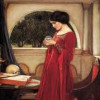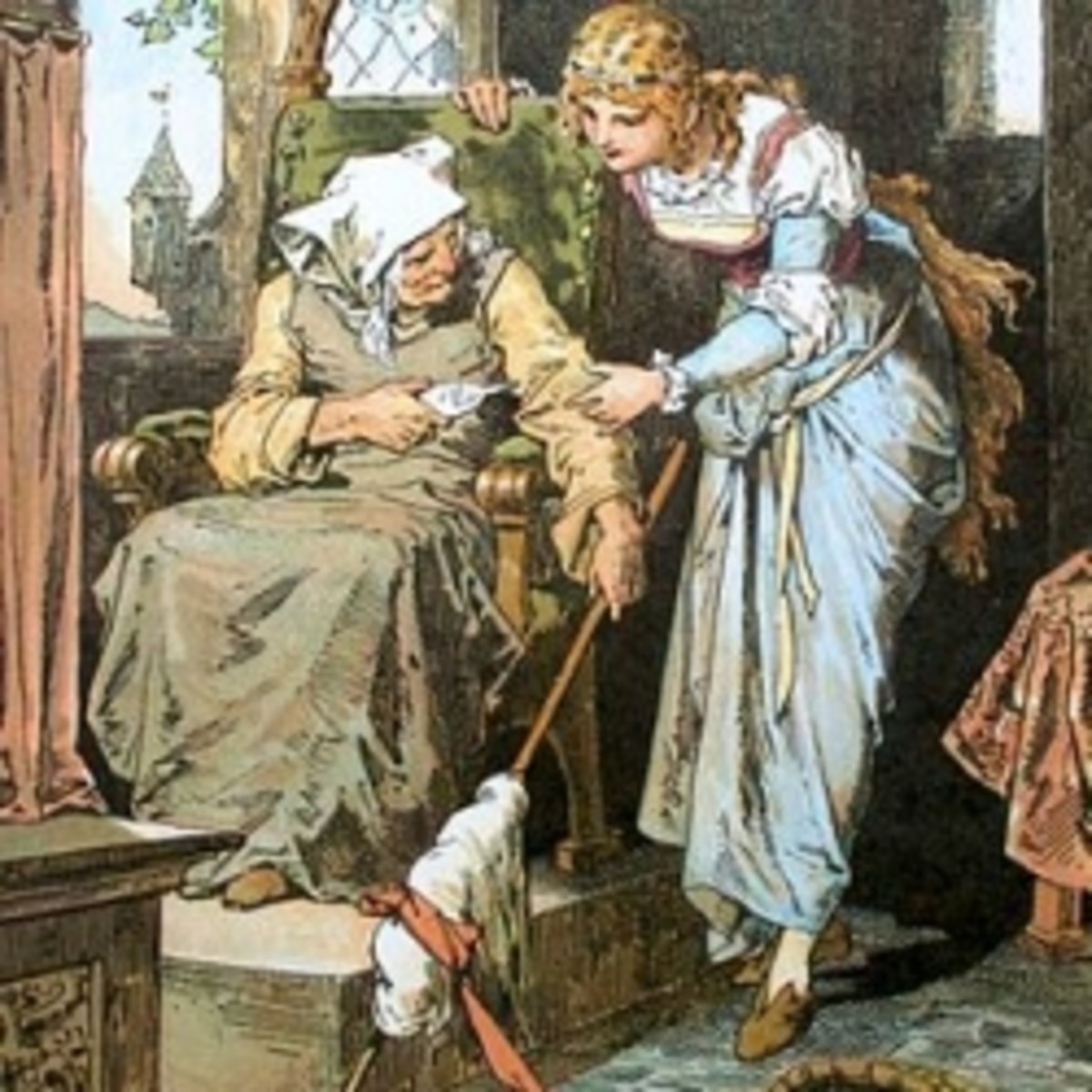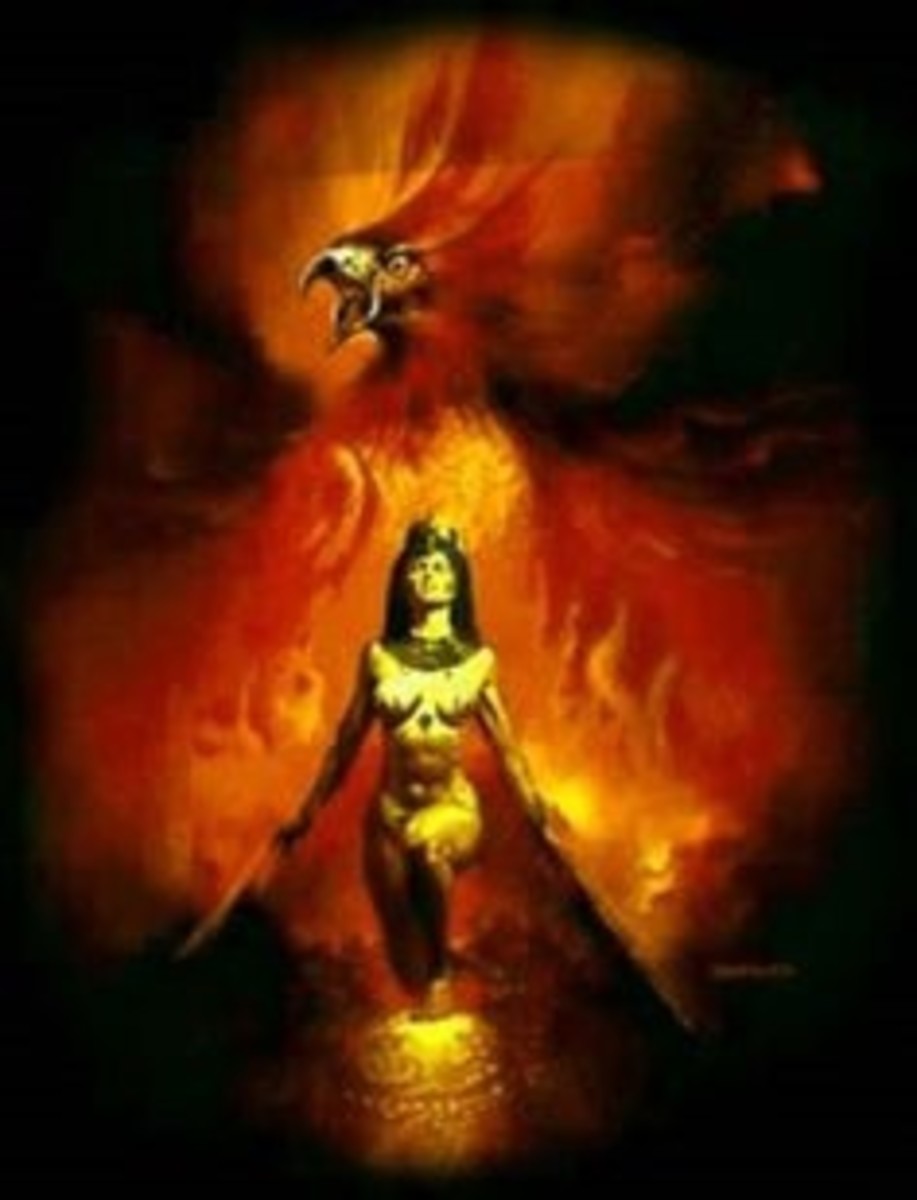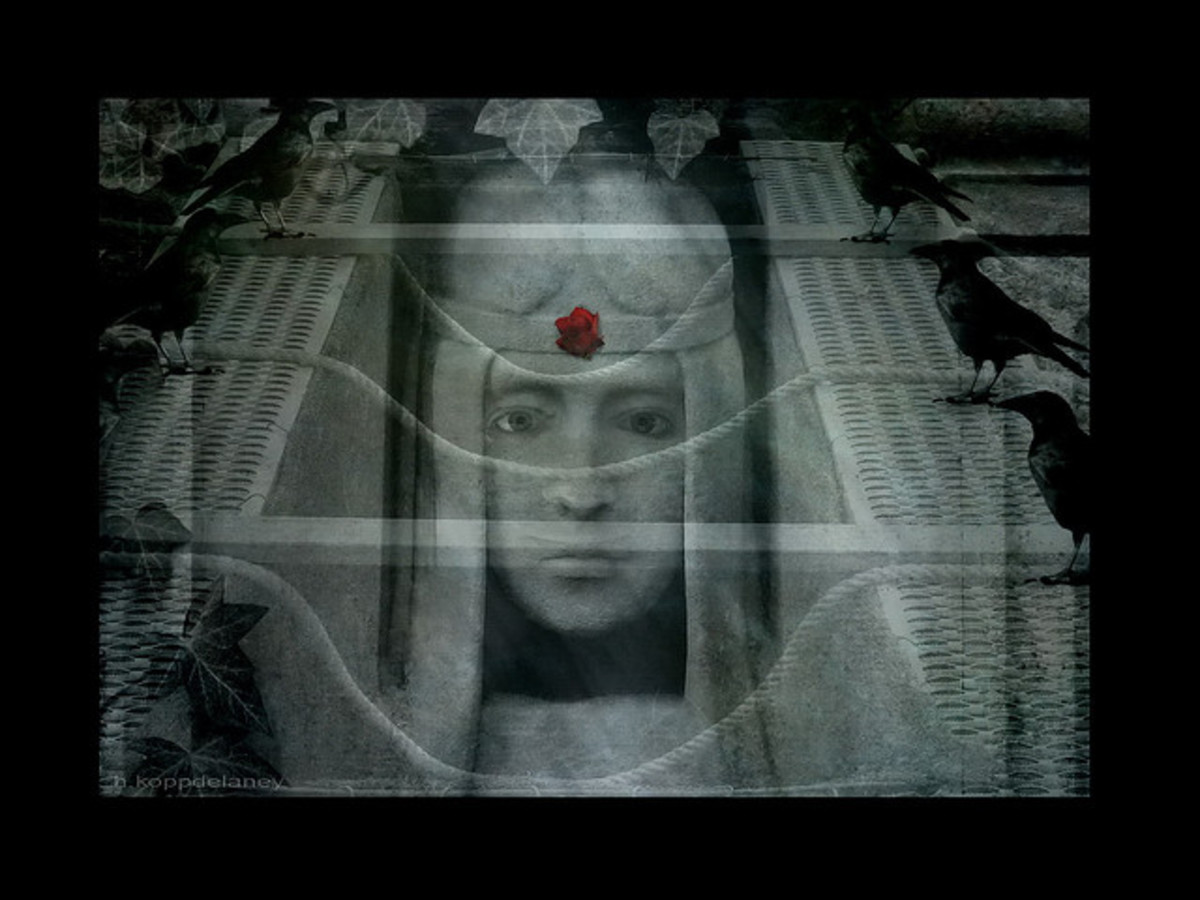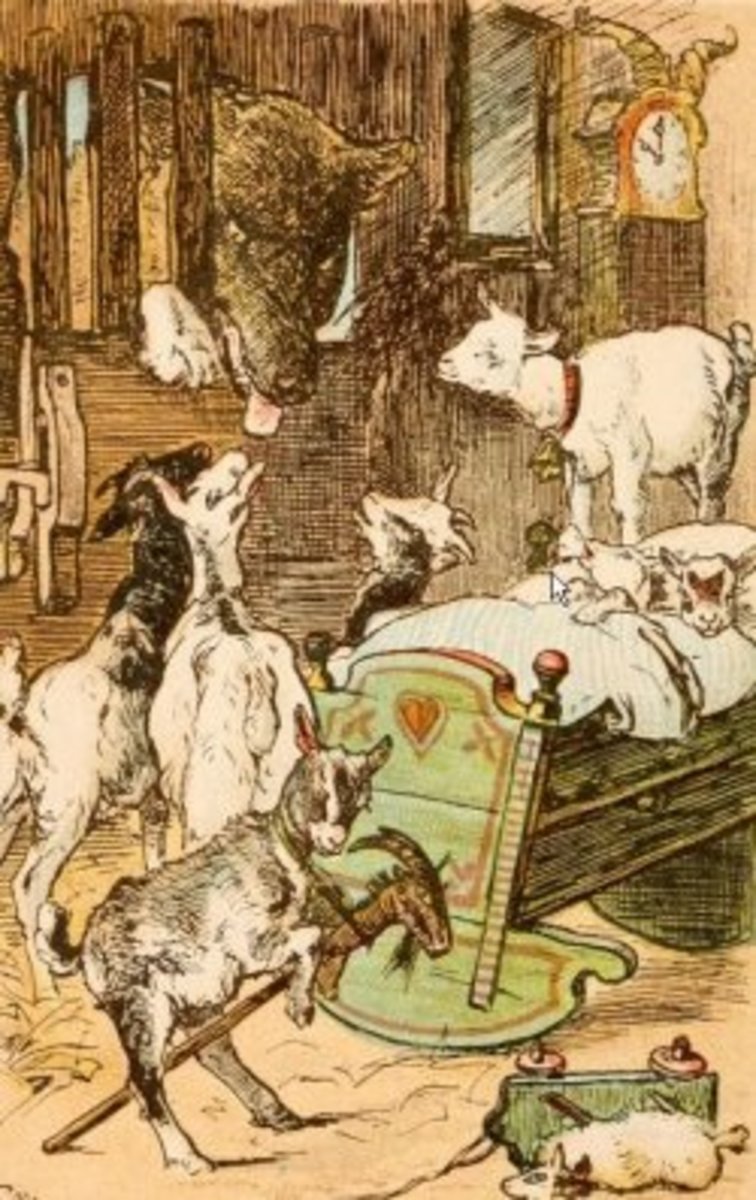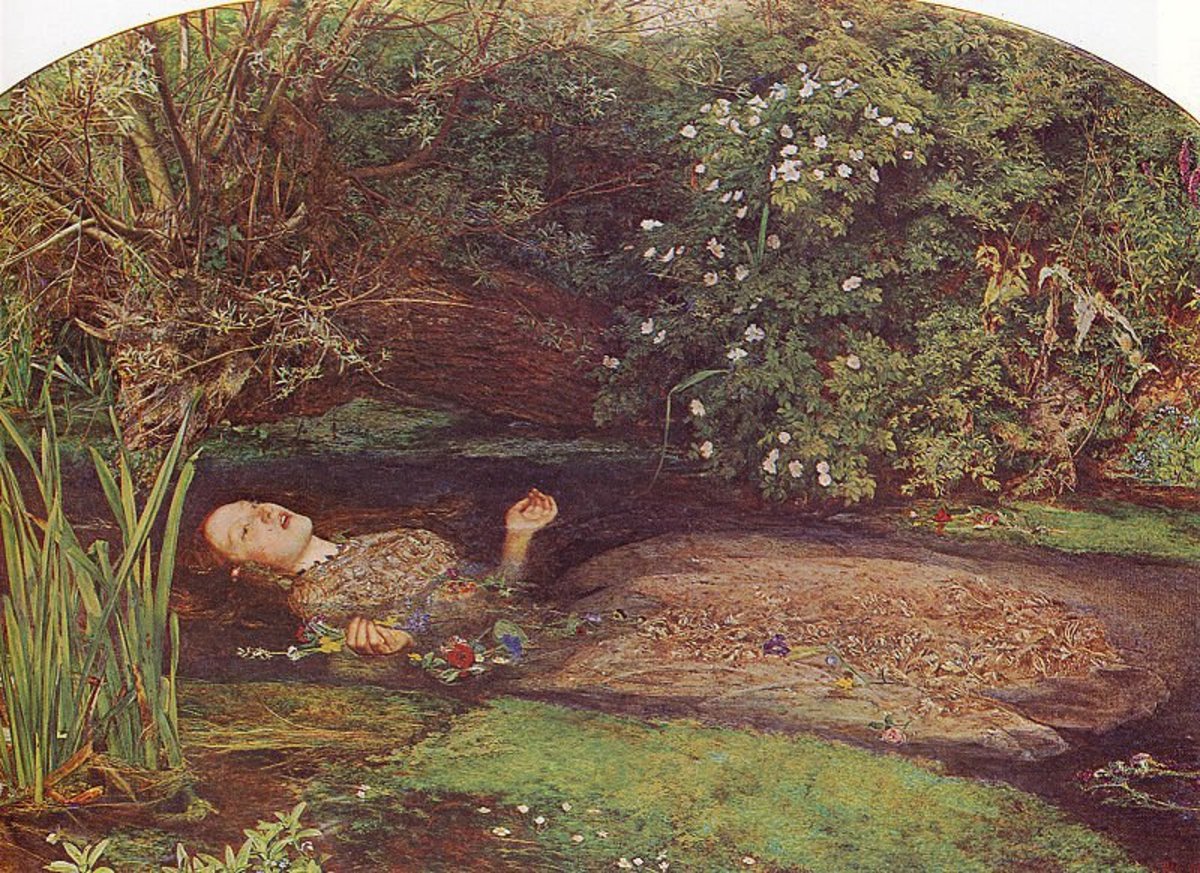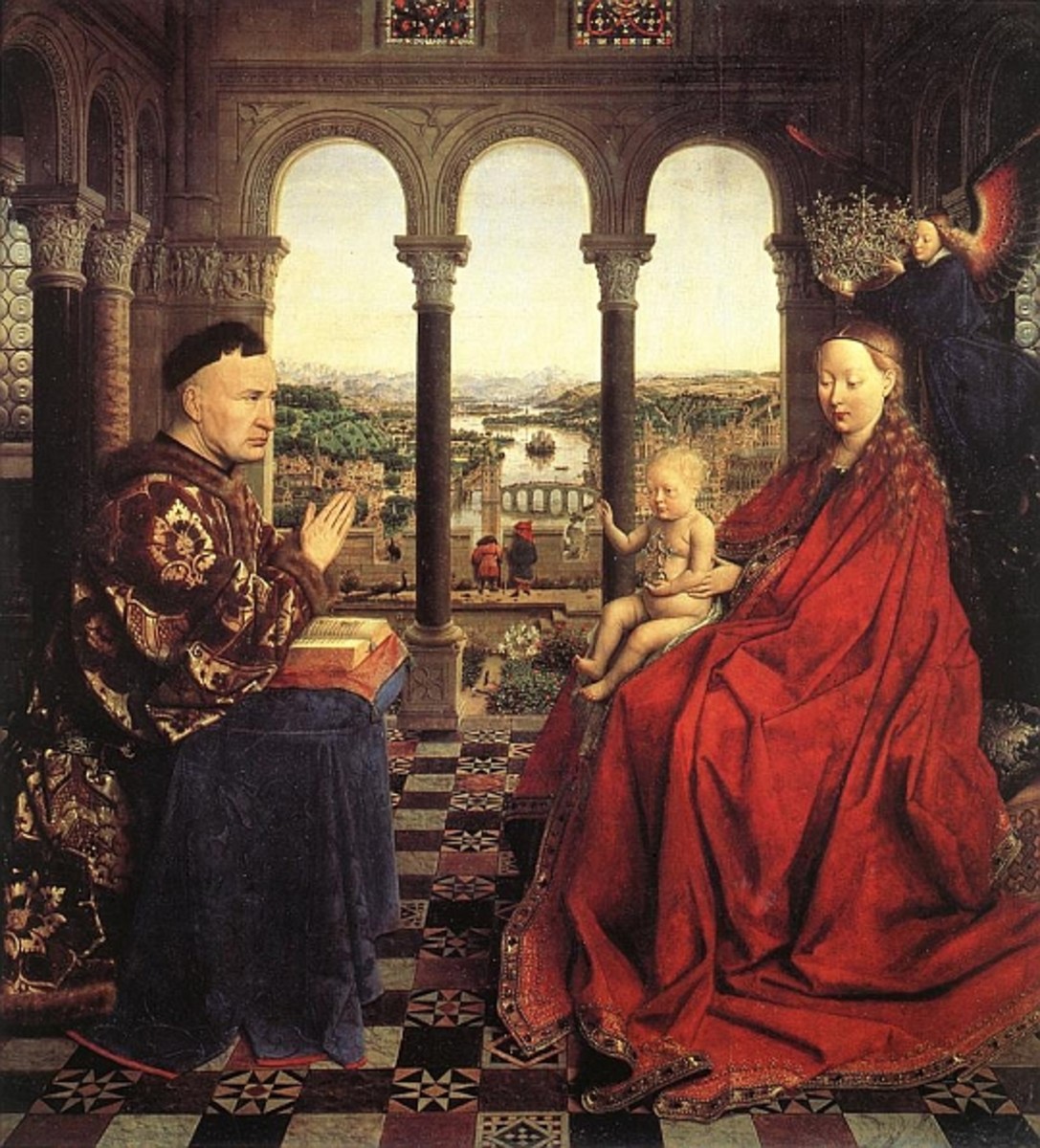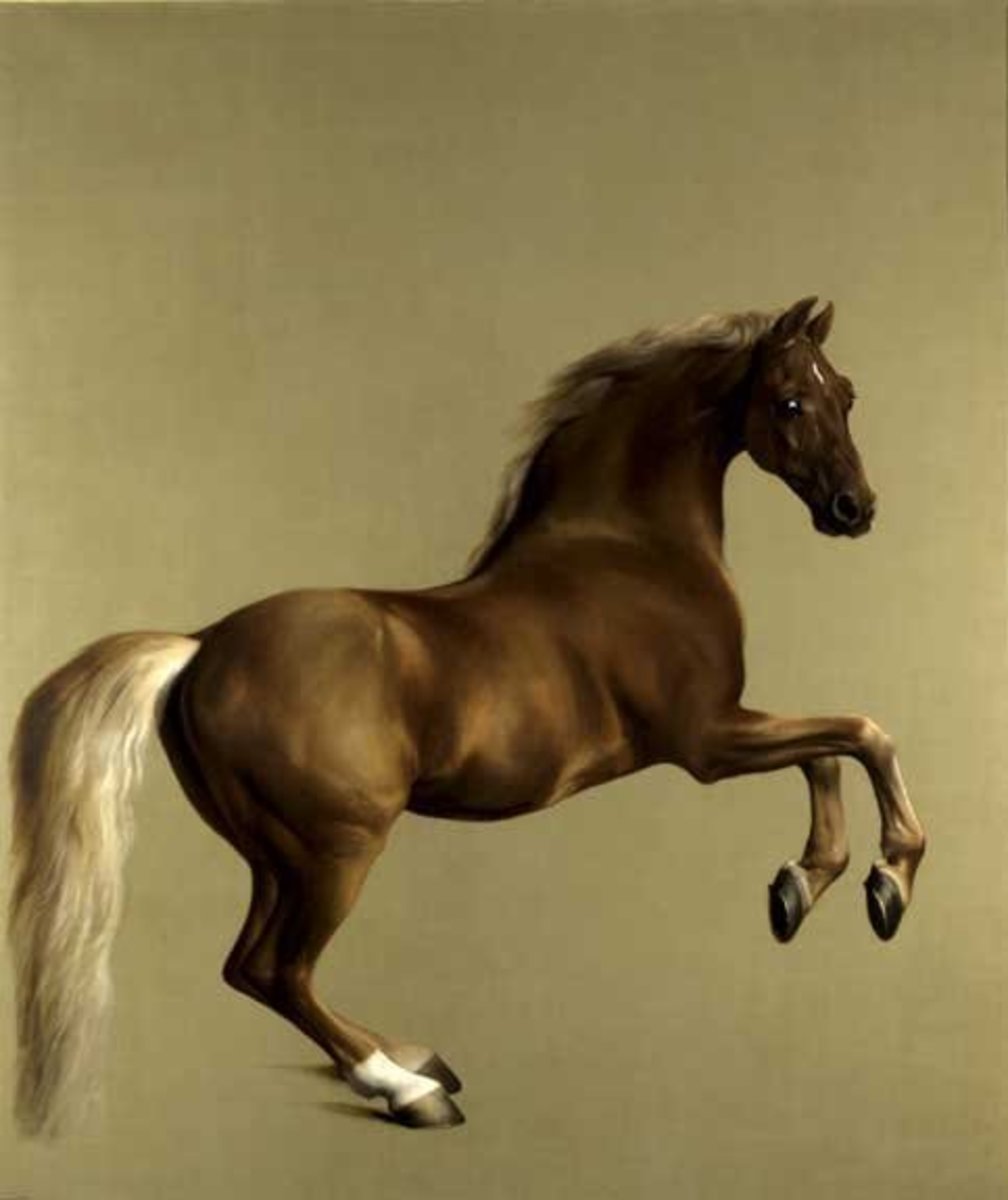Symbolism of Sleeping Beauty
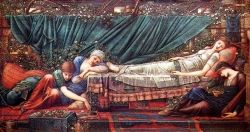
Sleeping Beauty (Rosamond/Briar Rose) is Not a Loser!
The fairy tale best known as Sleeping Beauty is a teaching tale, meant to instruct us in regards to our inner development. From the symbolic point of view based on alchemical/magical wisdom, it's a story about how our development can be arrested when we try to avoid suffering, when we learn to play it too safe.
A tale of Fate and Destiny - or, awakening to new perspectives
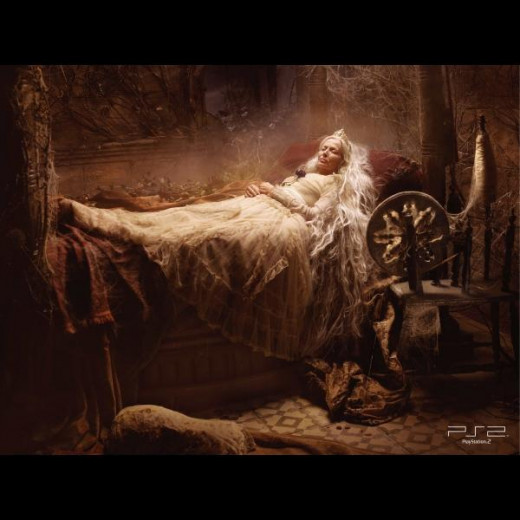
The fairy tale Sleeping Beauty is one of the most popular in European collections, and, like the other 2 biggies (Cinderella and Snow White) it's not at all about romance or even sleeping. It's a symbolically ordered story about human development of wisdom, compassion, or more expanded consciousness. When the princess awakens, it's a metaphor for the experience of expanded consciousness. If that sounds too New Agey for you, just think of the awakening as a life-altering revelation, learning something more or less life changing about oneself and thus about humanity, the world, the cosmos.
To back up a bit, I am a symbolist of the Jungian sort. Carl Jung was a student of Freud's who stressed the importance of the human unconscious, all that stuff that goes on "inside" us without the knowledge of our everyday personalities. We tap into our unconscious when asleep, or through unusual states of consciousness. Symbolic dream interpretation endeavors to interpret messages from the unconscious.
Jung studied ancient texts of an alchemical nature, and decided they were not about transforming physical lead to physical gold, but rather transforming inner symbolic, malleable lead of unconscious experience to the gold of wise, conscious living, to the experience of self knowledge.
Such alchemical texts were then meant as guidebooks for those who were interested in self observation, contemplation, and transformation. This transformational objective is true of much myth, such as the stories about Narcissus, Demeter and Persephone, Odysseus, and more. And of the stories I call transformational tales, like Sleeping Beauty.
The symbolism I use has been learned from Jungian writers, from interpreting dreams, and from studying and interpreting stories like Sleeping Beauty. Some good resources if you're interested in learning this art of symbology:
Symbolic Interpretation - writers I learned symbolic interp from:





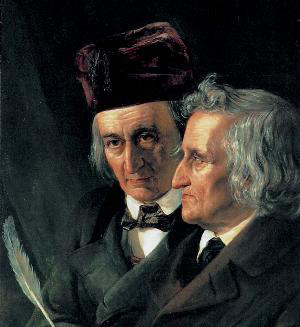
Different versions of Sleeping Beauty
Grimms, Perrault, and more
It's important to know that there are differing levels of alchemy (symbolically represented magical wisdom) imbedded in the different versions of very popular stories like Sleeping Beauty. For example, there is a difference between Disney's version of Sleeping Beauty and the one I am choosing. In my interpretation here in this lens I'm referring to The Sleeping Beauty in my edition of Grimm's Complete Fairy Tales, an old Nelson Doubleday edition. I can not find a version online quite like mine; this is the closest:Briar Rose
This online version has a fish instead of a frog, and the "beauty" is named Briar Rose rather than Rosamond. And it has fairies instead of wise women, apparently a popular move when these collected stories were published. Who needs wise women these days, anyway...
The Disney version is based on a mixture of Grimm's, I would say, and Perrault's, which you can read here: Perrault's Sleeping Beauty
Perrault's includes some challenges for Briar Rose which were once alchemical instruction, but they've been pretty badly distorted, which makes symbolic interpretation tough. When folks don't understand how wisdom and magic are encoded in the story, they get rid of what they don't understand, often (since the stories were promoted as children's entertainment) material that can seem just horrid, senseless gore.There are actually many versions of this basic story, from many countries, using the princess, the wise women/fairies, the spinning wheel and spindle in the tower, the long sleep, the thorn-covered castle, and the Prince.
Fairy Tale hard copy... - read up on transformational tales, and not so transformational versions



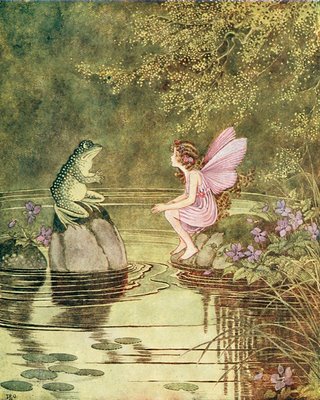
Wanting Something New to Develop
amazing births happening inside
First rule of my style of symbolic interp, a rule that lends a focus: ALL CHARACTERS AND EVENTS ARE TAKING PLACE WITHIN ONE INDIVIDUAL.Though these characters and events are also very likely happening outside of us in some manner too, in order to develop wisdom we must accept that the outer world is a mirror for our inner world. In order to create a new experience of the world, you can change your inside stories-YAY! It's a lot more accessible than trying to change the OUTER stories.
So, for example, Sleeping Beauty's character and her seemingly outward experiences mirror human inner experiences that are very common. The story would not be popular otherwise. However, in order for the story to point us in the proper direction of "what-is-going-on-inside-me", the setting includes some otherworldly stuff. Then we don't take it literally (although some people insist on doing so). With this in mind, the "fairy" realm is the realm of our psyches, of our inner storytelling imaginations, a place where we leave the literal, logical mind behind. This is the realm that symbolic story speaks of and to. If you're unfamiliar with symbolism, think of it as a way to express beyond the capacity of words, as happens when you look at a picture that speaks to you on many levels of experience. I will link to my website at the end if you would like some more basic instruction is symbolism.
Let's plunge into the story. Somehow, it has come to be that the human psyche likes to imagine our most glorious version of "me" as well represented by a royal family. That's why these transformational, alchemical stories are often involved with royal families. The prince and/or princess is working towards developing, unfolding, into his or her mature inheritance as king or queen. Likewise we are many of us working to reclaim the way of being in the world that is described well by king- and/or queendom. This somehow new way of being in the world is the experience the parents in the story are yearning for; remember, both the parents and the children are aspects of one inner self.
And once you are already king or queen? Why, you still wish for the next development! Humans are often never done with their cocreative projects! So there are often royal parents who yearn for children like crazy in these alchemical tales.
To quote my version: "In times past there lived a King and Queen, who said to each other every day of their lives, "Would that we had a child!"... Since we are talking about our inner experience here, we imagine the "child" as something new, specifically something new that comes from the union of inner masculine and inner feminine. This is called the alchemical marriage or sacred marriage, the Hieros Gamos, and I'll talk about it a tiny bit later.
Enter a magical nature figure, the frog, who tells the Queen "Thy wish shall be fulfilled". Surely this is not intended to be taken as a literal birth! Announcements from otherworldly sources are a universal story device to inform us this birth is metaphorical, an event of soul or spirit, the underworld or otherworld.
As shown in the illustration left, the frog is a frequent visitor to the fairy tale world of the psyche. Frog is very appropriate here, for the frog is a great shapeshifter, meaning he/she can manifest new developments. And Frog's often set into a story specifically to point to matters of human development, of initiation into new perspectives and therefore experiences. That's because the frog has a very visible metamorphosis from egg, to tadpole, to adult.
So the frog tells the Queen, in effect, "The new internal developments you wish for are about to happen!"
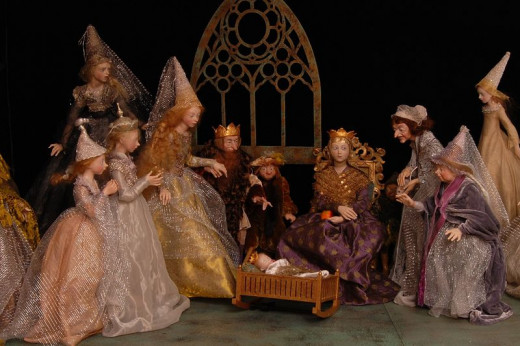
Next- the Wise Women Prophesy
and Dad tries to worm out of it
The baby girl is born, Dad is very happy, and they stage a feast. "Not only did he bid to it his relations, friends, and acquaintances, but also the wise women, that they might be kind and favorable to the child."
So here's a hint that the story might have some wisdom in it, for to be favored by the wise means they will bestow the gifts of wisdom upon you. He wants a wise daughter, so he values wisdom.
However, he's about to do an unwise thing, but that's the way of it in such instructional fairy tales. First we are given the objective (wisdom), and then the possible journey towards it, the way we might actually develop wisdom about something, in this case.
And wisdom angle I'm going to focus on here, the specific thing the King is needing to learn something about, is fate and destiny.
Fate and destiny were once a big deal, but generally folks learn little or nothing about them any more. Fate has a bad rep these days, interpreted simplistically as nothing but restrictions, which lends an "Oh well, what's the use" "fatalism" to believers. My definition of fate is this: all the materials you are given upon birth, your body, its development, family, time, place, traumas, gifts, some illnesses, accidents, friends, and more. Certain very crucial events seem to be fated; deaths of important loved ones, outrageous fortune like winning the lottery, etc.
What's destiny? It's what you do with your fate. Given the same circumstance, folks can react in very divergent ways. One lottery winner gives to charity and feeds starving kids, another blows it on a Lamborghini, gets in a wreck, and croaks. Fate is more or less malleable, which is the point to destiny.
The reason I'm sure this is a story of fate and destiny is the presence of the spinning wheel, the spindle, and the wise women. Though the baby girl's birth party is often depicted as a christening party, back in the old Norse/Germanic world and elsewhere, a person of any note would have seeresses come within a certain time span to speak the child's fate and destiny. They were speaking the knowledge of the Nornir, the goddesses who spun, measured, and cut the threads of each human life and destiny. In Greco-Roman myth we have the very similar three Fates.
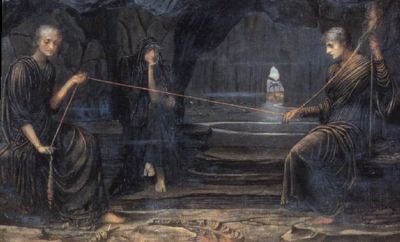
Fate and Destiny Obstructed
wheels can't hurt you, but spindles might
So the overarching theme of the threads of fate and destiny is symbolized in the spinning wheel, as well as, frankly, the fiber arts in general, since these ancient imaginings of fate and destiny's interwoven threads are very fundamental.
The spinning wheel is not needed in this story, however, and is not evident in my version, for the Princess is hurt by a spindle. Spindle-spinning is the old way, before the invention of the spinning wheel in about the late Middle Ages, so maybe this detail speaks of its ancient origins. The Norn is drop-spinning in this Waterhouse painting. The spindle both holds and twists the thread or yarn; the fibers are held on a distaff . Perhaps the spinner is Urdr, the Norn whose name means "fate" and who is referred to in the name of our planet, Earth.
However, the wheel is very symbolically useful, as an ancient and universal symbol of fate, or karma in the Eastern traditions. The tarot Wheel of Fate, number X in the deck, carries this symbolism. So the inclusion of both symbols strengthens our associations. Obviously both spinning styles include a round, balanced, spinning object, but the wheel emphasizes life as a turning wheel.
And a fundamental aspect of fate is that we cannot stay children forever. Our human development is like a wheel we cannot control. If that were not so, we might not mature towards wisdom, we would not fulfill our gifts, our destinies. That is the lesson of this story.
We cannot remain protected from the world by our parents forever, we have to go out and get hurt- especially true in the area of romance for the average adolescent/young adult. It's the old no pain, no gain concept.We need that finger prick; "In the fifteenth year of her age the Princess shall prick herself with a spindle and shall fall down dead", prophesies the excluded wise woman of the baby girl.
Though the death sentence is modified by the last wise woman to a long sleep, Father is still not happy with this eventuality; a daughter who sleeps for a hundred years. So he banishes all spinning equipment. He wants only happy, "good" stuff for his only daughter, and any parent can relate.
However, as this story tells us, even though he thinks he's banishing the difficult, dark, angry, traumatic aspects of his daughter's fate, he is only creating more trouble by trying to avoid human fate. For a hundred years, young men will suffer and die in the thorns that surround the castle, sufferings and deaths that represent Rosamond's inner suffering. She suffers, as many do, because her soul naturally strives to fulfill her destiny, impossible without knowledge of human suffering and pain, of the dark side. It doesn't take much...
By contrast, the prediction of falling down dead would symbolically refer to a death of the innocent, goody-goody, immature Princess, in preparation for her life as an adult. The death symbolizes an initiation, a normal part of adolescent development (it takes place smack dab in the middle, at age 15, as an indication) acknowledged in traditional societies. The choice here is this: the relatively quick but painful death of the old innocent self for the purposes of inner development, or a very long, dragged out period of unconsciousness. You're not very conscious if you only have awareness of the stuff your parents approve of. Mature humans are much bigger than that.
Curious about fate and destiny? - Reading and a deck for inner work
The best of Fate and destiny books out there right now, I'd say...




Question: Have you experienced the dark side as useful in your maturation process?
The Inner Shadow Prince - alchemical symbolism and inner work is based on the opposites
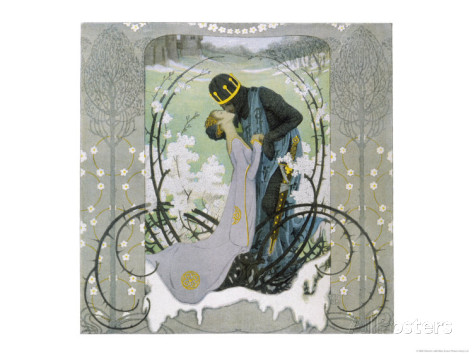
When Rosamond climbs the tower stairs on her fifteenth birthday, she finds a door with "a rusty key sticking out of a lock". I'm going to pause here and deal with this easily ignored but universal symbol.
I'm sure you can figure out that unlocking and opening this door means something new within the psyche is being opened, experienced. People have lots of dreams about doors, and that's the general interpretation. It's similar to the desire to have a child, in that it represents some new experience.
However, you may not have thought of this as a sexual metaphor. The key is the male part. I trust you get my drift. Remember those stories about ladies in castles wearing chastity belts? What the heck does that have to do with wisdom, with human inner development?
In alchemy, we learn how to see both sides of the story. We learn to see life in shades of grey, rather than as black and white. And another way to represent black and white, to represent opposites, especially in stories, is by using another very natural way of ordering phenomena and experiences; the masculine and feminine aspects of experience.
Using the concepts of masculine and feminine,discovering them BOTH as aspects of ourselves, understanding and using BOTH their powers, is one way to imagine our holistic development. From this perspective, love in a romantic sense mirrors the innate desire to realize our whole selves from the inner perspective. Inner encounters and intimacies with our animus (the inner man for a woman) and anima (inner woman for a man) are portrayed in such fairy tales, in our dreams- and indeed in lots of other stories too, such as the now very popular vampire tales!
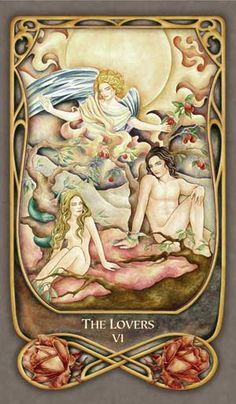
Alchemical Lovers and Marriages, Symbolism that Lives On in Tarot
The Lovers, VI
The alchemical inner meeting and joining of the masculine and feminine opposites was a popular art subject back in the heyday of alchemical manuals. The tradition lives on in tarot, especially the major arcana card, VI, The Lovers, which speaks of the same matter Sleeping Beauty and other such magical stories refer to. The tarot deck is, like the transformational "fairy tales", an instructional tool for alchemical inner development. This pretty rendering from the Fenestra deck by Chatriya includes, as many tarot VI illustrations do, a winged presence, as did many of the old alchemical texts. The winged presence is the metaphorical clue writ rather large that we are talking about inner, or non-physical, events.
More divination - starting with the dark Mayan deck I love
Tarot is intrinsically alchemical, based on the human developmental journey.





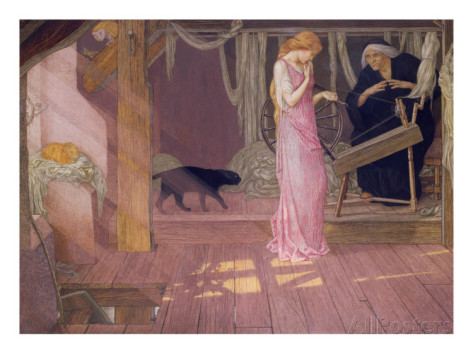
The Sacred Wound?
inner meeting with the Other as the destiny woven of fate-wounds
click on image to view at AllPosters.com
When Rosamond turns the rusty, unused key, she symbolically enters into the experience which her father had hoped she would avoid. She meets her fate in the form of the old woman spinning. This specific aspect of her fate is one that involves pain and suffering for her. Because adolescents are moving away from the protection of parental rule, they are naturally going to get hurt, maybe many times. The finger pricking symbolizes her initiation into the adult relationship with pain. If you think about it, you realize that your experience of pain is morphing as you move out of childhood. Children are more in the moment, and, more like animals, they don't dwell on the meaning of their pain, of events in general. They just get on with the next thing in life.
So in going beyond the known, overprotected space her parents have kept her to, whether an adolescent princess or older woman (the story could be told from the mother's perspective, with Rosamond as her inner restricted adolescent), this female person enters into a new way of experiencing life. Questions and quests that might never have arisen if she had not suffered are now a part of her experience, and she can use them to create a different destiny. She will wake up as a new person- fairy tale weddings always imply this, a new state of union.
However, in order to show us what happens when we avoid this loss of innocence, the princess and the King and Queen and all the castle are frozen, a good metaphor for what happens when we refuse to deepen our human experience by avoiding the painful parts of our fates (the uninvited wise woman's prophecy). The frozen castle is the result of resisting this initiation, rather than going with the developmental flow. The frozen state of the castle also cleverly describes the truth that our ways of being in the world pervade and influence everything we experience. If we are resistant and stagnating internally, that state colors everything in our world. That's how we see life, how we relate.
What is required to reverse this situation, then, to waken the castle, the King and Queen and princess? Why, death and suffering, of course! Princes (symbolic for this princess's inner masculine aspects) hear tell there is a beautiful woman asleep in a castle that cannot even be seen any more, it's so overgrown by a hedge of thorns, "thicker every year". Just so does it become increasingly difficult, generally, to move towards our most glorious destinies without fear and undue caution the older we get, the longer we run from it. Youth is the best time, adolescence, actually, to become acquainted with the magical gifts of grief, loss, and death. Otherwise we can just slowly rot away in life, in a relative state of unconsciousness as to our inner workings, our authentic selves.
Prolonging the Suffering - force and control don't always help
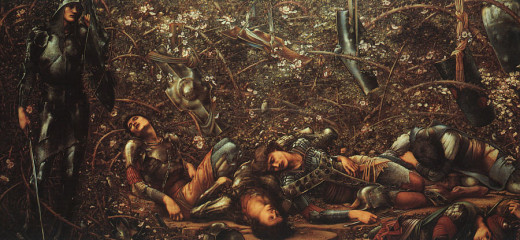
So I'll mention here that, among many other things, archetypal or symbolic masculine properties include those of forcing, aggression, and controlling. For a list of basic masculine/feminine qualities, see the end of this lens. In alchemy, in looking at our human holistic natures, we are not to stereotype any qualities, tendencies, or behaviors negatively. For every gift, tendency, and ability is useful and available to all of us. These masculine tendencies and skills which are a part of all of us just tend to be more natural for boys and men to overtly express. The masculine is the key to the unlocking of the alchemical doors, remember! The key is useless without the lock, though.
The trick is to use our masculine wisely- in fact, to balance it with the feminine, the key and the lock. For example, when someone refuses to acknowledge, let alone support, the natural developmental processes, processes we could equate with Nature itself, then we get a lack of balance, specifically a lack of earth element wisdom. My contemporary culture sure does that. A glaring example of this lack of trust in the feminine earth element is my society's increasingly controlling the birthing process. This control is exactly like the King's trying to keep his daughter from experiencing her dark side, her human fear and suffering. Since childbirth has some of the greatest initiation potential for mothers, women are robbed of their developmental rights when measures that should be used only in emergencies or other unusual situations become standard operating procedure.
The princes "tried to force their way through" to the princess, and much suffering was experienced within Rosamond's psyche, as she kept trying again and again to figure this inner connection, this wisdom, this balancing act, out. This aggressive,overcontrolling sort of approach to life, a continuation of the father's controlling his kingdom by banning all spinning, isn't going to get anywhere, since it represents the immature, unconscious, unbalanced way. In fact, the forceful princes were as trapped as the frozen residents of the castle; "not being able to get free, [they] there died a lamentable death."
Freedom, mentioned in this last excerpt, is a common theme in symbolic poetry, song, and story. Human development toward wisdom is easily described as a movement towards inner freedom of experience. Experiential freedom is often characterized by freedom from fear, and it's fear of death/fear of losing his daughter that caused this whole stagnant state of affairs in the inner castle to begin with. We could even imagine fear as a feeling quite the opposite of freedom. Surely the frozen castle could represent the inner state of fear, which is associated with resistance. We are afraid of something when we are against, when we assume it's bad, and thus we are in resistance to it.
A hundred years passes; symbolically, large multiples of ten (the Wheel of Fortune/Fate/Karma tarot number, remember?) signify timeless time, in order to make sure we don't get stuck in everyday consciousness while we listen to stories that are meant to speak to our non logical souls. A particular prince (recall that we are all princes and princesses, kings and queens, inside) hears of Rosamond, and, though many have fallen into the thorn hedge's clutches, he says the right thing; "I do not fear to try."
This is the right and correct first step, to address the matter of fear. For the misuse of masculine control and aggression is a symptom of insecurity and fear; the King did not trust the feminine flow, that his daughter would get what she needed. He had no faith in her ability to deal with her fate and weave a glorious destiny, no faith in her as a part of Life Itself. Traditional Asian martial arts are big on this bit of addressing fear itself first, addressing the inner state, as I suppose any warrior tradition would.
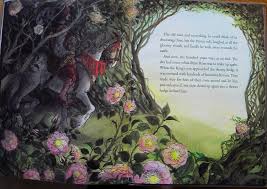
The Prince Wins Through Understanding
force invites force, acting with fear creates more fear
Aside from the fact that there are way too many illustrations of Sleeping Beauty asleep, there are also almost none to be found of the manner in which the Prince really gets through the thorns. That's because the way it happens makes no sense from the logical perspective of an overly heroic society, which assumes that force must be exerted in order to "get somewhere".
No, this Prince is a posterboy for nonviolent resistance, for love bloomed (in the form of roses) as he approached the castle. The thorns which had cut and held the other suitors "parted and let him pass, and then closed behind him in a thick hedge." This guy is like Moses parting the Red Sea; this is a holy moment, in a sense the same as the inner alchemical marriage itself, if the hedge and castle walls represent the inner walls between a person's masculine and feminine selves. This story tells us that the Prince's uncontrolling, nonviolent manner is the way for the masculine to enter into the feminine heart.
Flowers are symbolic of the concept used in everyday speech of "flowering", of development, a word meaning "unfoldment". This sort of development (not the real estate kind) is of a spiritual or religious type, meaning it involves soul and spirit. Flowers are not only sexual, they are also expressions of beauty in color, form, and scent, and beauty has no purpose other than to please heart and soul and spirit. That's why they represent ethereal love, in general.
This guy has something else on his side, though. The curse is about to end, for that was its length; one hundred years. In this we are taken back to the matter of fate, which, again, includes our most important human developmental events. Whether we try to avoid it or not, adulthood eventually comes. The question is, what level of mature wisdom will be reached, or conversely, how much of our potential, our destiny, will we avoid, through fear and avoidance of pain and suffering? And also- how long will it take to initiate our understanding of the transformational invitation intrinsic to pain and suffering? Some folks are acquainted with the wisdom behind suffering and death at a very early age- some meet it in the arms of death itself, after many decades of life. Of course it's all good...
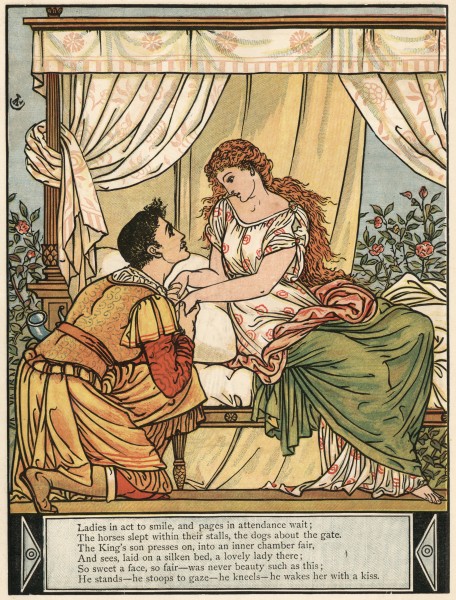
Waking Up: The Same, only Different
before enlightenment, chop wood...
There she is awake- Whew! So many images of her sleeping...it's kind of scary.
You may notice that there's really nothing very sappy happening in this story until Disney (and/or Perrault) gets a hold of it. The prince says "I will win through and see the lovely Rosamond", for truly seeing the nature of our inner realities is really all that's needed for us to join together our masculine and feminine aspects within the psyche, to begin with. Then we can go on to having other realizations about our masculine and feminine selves as time goes on. But first we need to recognize that they exist, basically. That's what the prince is doing, recognizing that he has an inner feminine nature that's lovely. Rosamond sees that he is kind, in this version. He means her no harm; she has discovered a balanced aspect to the masculine, seen past her inner control freak, that refuses to allow earth element things to happen naturally.
From a feminine Rosamond or Queen perspective, our working in "the world", the symbolically masculine struggle for worldly success, can give women insight into their inner masculine selves, our animus aspects in Jung's terms. This will change the way we experience ourselves and the world. By the same token, when men get to spend time at childrearing and domestic occupation and/or other more feminine venues, they will get to develop a more complete understanding of their inner feminine or anima.
Rosamond looks kindly on him when he kisses her beautiful face, and at the joining of masculine and feminine, the case of arrested development passes. She is awakened, a word often used in myth and fairy tale to mean a new level of awareness, an understanding of something we were previously ignorant of. Growing towards wisdom is a long succession of such awakenings, for most humans.
The fact that everything is the same on the outside, though Rosamond and the prince have experienced awakening, is expressed in the well known Zen adage "Before enlightenment, chop wood, carry water. After enlightenment, chop wood, carry water." Much has changed inside, while the world remains the same. It's only our personal perspective that is different.
The story has lots of subtleties I can't address here, in particular because, like other transformational tales, we are meant to imagine these characters as all inhabiting one psyche. The themes of birth and death, of renewal, of love and its opposite, fear, are explored. Fate and destiny are broached, and we learn that we may try to keep our loved ones safe in castle walls, however metaphorically. But if we do we delay the transformative opportunities of suffering, for as this tale would have it, the Fates are more powerful than human will.
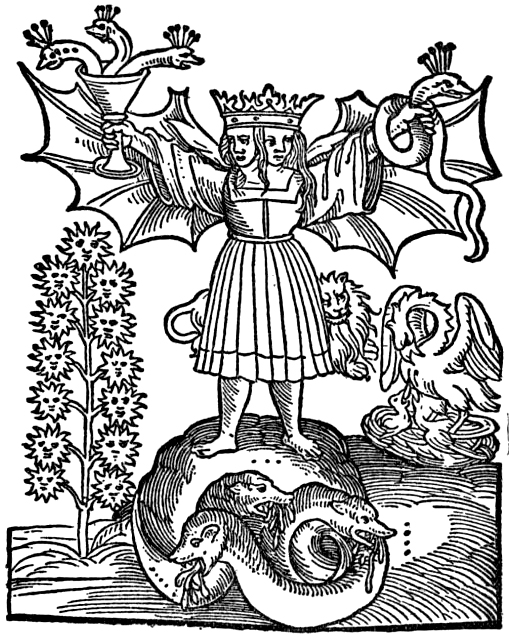
That's a wrap!
other resources
Hopefully, you learned that Sleeping Beauty is not just a lame-o potato who lies in bed while the guys do all the work, if you didn't know that already. If your interest was piqued, my website, Sorcerer's Stone, has more info about symbolic story, and more interpretations in my blog. Here it is: sorcerersstone.net
Sur la Lune is a great fairy tale resource online: click here
Check out the great and wonderful Cabinet des Fees (fairy cabinet) e zine. They've published a symbolic review of mine of the film Black Swan, and an interpretation of a Finnish tale I love, The Girl Who Sought her Nine brothers. To go to Cabinet, click here
Contemporary Symbolic Film - symbolism is everywhere...
Beyond the fairy tale genre, there are lots of stories with loads of symbolic content. In my new e book Poetry in Motion: 19 Symbolic Reviews of Transformational Film, I did interps like this one of Sleeping Beauty for films like The Game, Dead Man's Chest, Fight Club, The Village, Shipping News, and more. All you need to download and read it is a computer (some people think you have to have a Kindle or other reader). If you're intrigued by symbolism, check it out!
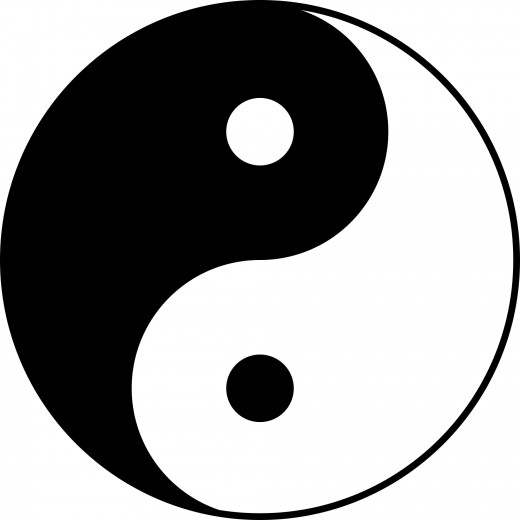
Basic Masculine and Feminine Properties
gold and silver, black and white, earth and air....
Here is a basic outline of masculine and feminine qualities. There is a fair amount of variation and flexibility in these opposites. It's not meant to get people into rigid interpretations of life, but just as a guideline helpful in symbolic interpretation and alchemy.
Masculine (yang)
light, the sky
creative and emotional energies of fire
creative energies of air (intellect , ethereal)
gold , the sun
expansive, expression, seeing, up
structure, hard, beauty of perfection
problem solving, goals
abstract thinking, categorizing
discrimination, separation
“above” personality (spirituality)
Feminine (yin)
dark, the earth
creative and emotional energies of water
creative energies of earth (birth/death cycle, soul expression )
silver, the moon
contracting, receiving, hearing, inner, down
change, flexible, beauty of imperfection
wisdom through experience, process
complexity and paradox, symbolism, and poetics
finding similarities, bringing together
“deeper” than personality
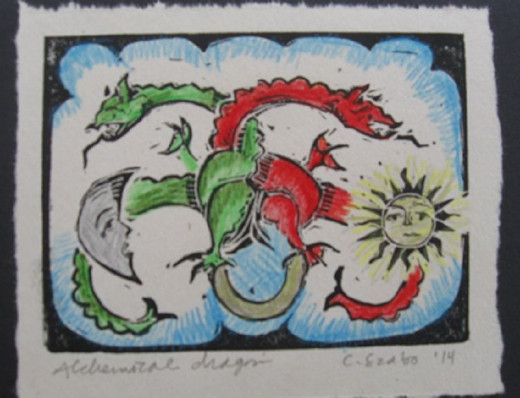
Alchemical Art
by none other than me!
I'm also a graphic artist, so I thought I'd point out my Etsy shop where my "Alchemy" print series (and others) reside. Image is of an alchemical dragon. You know by now that's a two sided dragon that's been joined, a sort of alchemical marriage. Dragons represent all sorts of personal power. Click on the image to enter my Ravenlight Arts shop!
I won't be sad if you don't...
